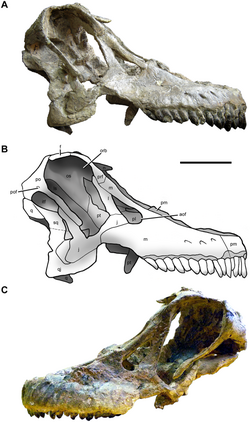Biology:Diamantinasauria
| Diamantinasaurians | |
|---|---|

| |
| Skull of Sarmientosaurus | |
| Scientific classification | |
| Domain: | Eukaryota |
| Kingdom: | Animalia |
| Phylum: | Chordata |
| Clade: | Dinosauria |
| Clade: | Saurischia |
| Clade: | †Sauropodomorpha |
| Clade: | †Sauropoda |
| Clade: | †Macronaria |
| Clade: | †Somphospondyli |
| Clade: | †Diamantinasauria Poropat et al., 2021 |
| Genera | |
Diamantinasauria is an extinct clade of somphospondylan titanosauriform sauropod dinosaurs with close affinities to the Titanosauria, known from the early Late Cretaceous (Cenomanian-Turonian) of South America and Australia. It was named by Poropat and colleagues in 2021, and contains four genera: Australotitan, Savannasaurus and Diamantinasaurus from the Winton Formation of Queensland, as well as Sarmientosaurus from the Bajo Barreal Formation of Patagonia. The existence of the clade indicates connectivity between Australia and South America via Antarctica during the Cretaceous period.[1]
| Titanosauria |
| ||||||||||||||||||||||||||||||||||||||||||||||||||||||||||||||||||||||||||||||||||||||||||||||||||||||
Though Diamantinasauria has been recovered consistently as a clade in the phylogenetic analyses of Poropat and colleagues, its placement within Titanosauria has fluctuated, meaning that while it appears to be relatively stable as a clade, its content and definition may change with further analysis and study.[2]
In their 2024 description of the basal titanosaur Gandititan, Han et al. recovered the Diamantinasauria as the sister taxon to the Titanosauria, rather than within it. The results of their phylogenetic analyses are shown in the cladogram below:[3]
| |||||||||||||||||||||||||||||||||||||||||||||||||||||||||||||||||||||||||||||||
References
- ↑ Poropat, Stephen F; Kundrát, Martin; Mannion, Philip D; Upchurch, Paul; Tischler, Travis R; Elliott, David A (2021-01-20). "Second specimen of the Late Cretaceous Australian sauropod dinosaur Diamantinasaurus matildae provides new anatomical information on the skull and neck of early titanosaurs" (in en). Zoological Journal of the Linnean Society 192 (2): 610–674. doi:10.1093/zoolinnean/zlaa173. ISSN 0024-4082. https://academic.oup.com/zoolinnean/advance-article/doi/10.1093/zoolinnean/zlaa173/6104802.
- ↑ Carballido, J.L.; Otero, A.; Mannion, P.D.; Salgado, L.; Moreno, A.P. (2022). "Titanosauria: A Critical Reappraisal of Its Systematics and the Relevance of the South American Record". in Otero, A.; Carballido, J.L.; Pol, D.. South American Sauropodomorph Dinosaurs. Record, Diversity and Evolution. Springer. pp. 269–298. doi:10.1007/978-3-030-95959-3. ISBN 978-3-030-95958-6.
- ↑ Han, F.; Yang, L.; Lou, F.; Sullivan, C.; Xu, X.; Qiu, W.; Liu, H.; Yu, J. et al. (2024). "A new titanosaurian sauropod, Gandititan cavocaudatus gen. et sp. nov., from the Late Cretaceous of southern China". Journal of Systematic Palaeontology 22 (1): 2293038. doi:10.1080/14772019.2023.2293038.
- ↑ Poropat, Stephen F.; Mannion, Philip D.; Upchurch, Paul; Hocknull, Scott A.; Kear, Benjamin P.; Kundrát, Martin; Tischler, Travis R.; Sloan, Trish et al. (2016-10-20). "New Australian sauropods shed light on Cretaceous dinosaur palaeobiogeography" (in en). Scientific Reports 6 (1): 34467. doi:10.1038/srep34467. ISSN 2045-2322. PMID 27763598.
Wikidata ☰ Q105729950 entry
 |

